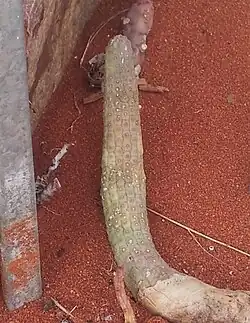Lavrania
| Lavrania | |
|---|---|

| |
| Scientific classification | |
| Kingdom: | Plantae |
| Clade: | Tracheophytes |
| Clade: | Angiosperms |
| Clade: | Eudicots |
| Clade: | Asterids |
| Order: | Gentianales |
| Family: | Apocynaceae |
| Subfamily: | Asclepiadoideae |
| Tribe: | Ceropegieae |
| Genus: | Plowes[2] |
| Species: | L. haagnerae
|
| Binomial name | |
| Lavrania haagnerae Plowes[2]
| |
Lavrania is a monospecific genus of plants in family Apocynaceae. Its only species is Lavrania haagnerae, endemic to Namibia.[2] Its natural habitat is rocky areas.[1]
Taxonomy
The genus and species were first described in 1986.[2] Phylogenetic studies have shown the genus to be monophyletic, and most closely related to the stapeliad genus Hoodia. Marginally more distantly related is a sister branch of related genera including Larryleachia, Richtersveldia and Notechidnopsis.[3]
References
Wikimedia Commons has media related to Lavrania.
- ^ a b Craven, P. (2004). "Lavrania haagnerae". IUCN Red List of Threatened Species. 2004: e.T46823A11083872. doi:10.2305/IUCN.UK.2004.RLTS.T46823A11083872.en. Retrieved 2023-02-14.
- ^ a b c d "Lavrania Lavrania". Plants of the World Online. Royal Botanic Gardens, Kew. Retrieved 2023-02-14.
- ^ Bruyns, P.; Klak, C. & Hanacek, P. (2014). "Evolution of the stapeliads (Apocynaceae-Asclepiadoideae) – repeated major radiation across Africa in an Old World group". Molecular Phylogenetics and Evolution. 77 (1): 251–263. Bibcode:2014MolPE..77..251B. doi:10.1016/j.ympev.2014.03.022. PMID 24721383.
